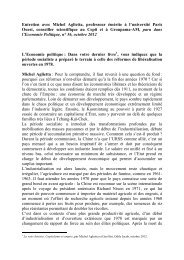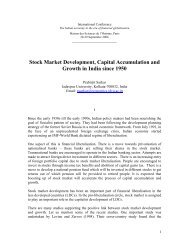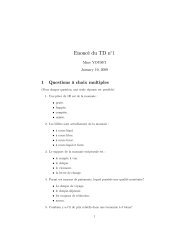Does the Entry Mode of Foreign Banks Matter for Bank ... - EconomiX
Does the Entry Mode of Foreign Banks Matter for Bank ... - EconomiX
Does the Entry Mode of Foreign Banks Matter for Bank ... - EconomiX
You also want an ePaper? Increase the reach of your titles
YUMPU automatically turns print PDFs into web optimized ePapers that Google loves.
Market share. We calculate a bank’s market share as its share <strong>of</strong> assets over totalbanking sector's assets.5. DataWe obtained data from Bureau van Dijk's <strong>Bank</strong>Scope database, version 2006. Forour sample, we select three most advanced countries in Central Europe: <strong>the</strong> CzechRepublic, Hungary, and Poland. We choose <strong>the</strong>se countries <strong>for</strong> a number <strong>of</strong> reasons.Indeed, we are first motivated by <strong>the</strong>ir very high levels <strong>of</strong> <strong>for</strong>eign bank penetration incomparison with o<strong>the</strong>r transition countries, and even with o<strong>the</strong>r developing countries.Consequently, greenfield and merger and acquisition entries take place most extensivelyin <strong>the</strong>se countries. This <strong>the</strong>re<strong>for</strong>e facilitates <strong>the</strong> analysis <strong>of</strong> different modes <strong>of</strong> entry onbanks’ cost per<strong>for</strong>mance. Second, <strong>the</strong> activities <strong>of</strong> <strong>for</strong>eign banks <strong>the</strong>re are betterdocumented than in o<strong>the</strong>r transition economies. Finally, <strong>the</strong> levels <strong>of</strong> economicdevelopment between <strong>the</strong> three countries are relatively homogeneous, which facilitates<strong>the</strong> cross-country comparison.As it is commonly known by academic researchers and pr<strong>of</strong>essionals, <strong>the</strong> data <strong>for</strong>banks from less developed and transition countries require substantial editing be<strong>for</strong>e areliable sample can be constructed. We <strong>the</strong>re<strong>for</strong>e carefully review our data to avoiddouble counting <strong>of</strong> institutions, to exclude non-bank financial institutions from <strong>the</strong>sample. We also exclude banks that are not commercial, cooperative and savings banks toensure that we are estimating per<strong>for</strong>mance based on a relatively homogeneous group <strong>of</strong>banks. With respect to <strong>the</strong> type <strong>of</strong> account, we prefer unconsolidated accounts toconsolidated ones wherever available. Once <strong>the</strong> type <strong>of</strong> account chosen, we take <strong>the</strong> onefollowing <strong>the</strong> international financial reporting standards (IFRS) wherever available. Ifnot, we take <strong>the</strong> account with local accounting standards. Never<strong>the</strong>less, sometimes IFRSdata are available <strong>for</strong> only one or two years while longer time series are available in localstandards. In such cases we use local standards. Thus, our final sample consists <strong>of</strong> 153banks from <strong>the</strong> Czech Republic, Hungary, and Poland over <strong>the</strong> period 1994 to 2004. Thedistribution <strong>of</strong> banks by ownership and mode <strong>of</strong> entry is given in table 2.While <strong>Bank</strong>Scope has a very large coverage <strong>of</strong> banks over <strong>the</strong> world, thisdatabase provides in<strong>for</strong>mation on bank ownership only <strong>for</strong> <strong>the</strong> current calendar year.-25-




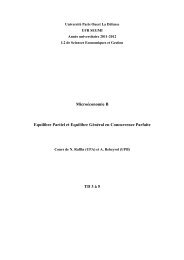

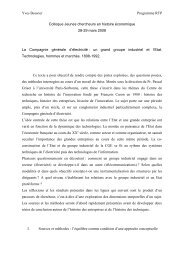

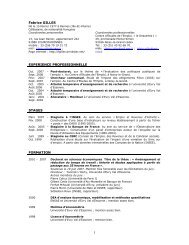
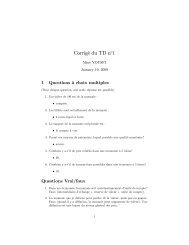
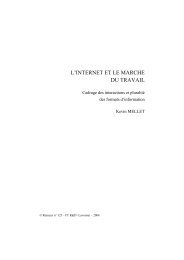
![P * 1 JTZWL_TZY OP^ Sd[Z_Sl^P^ !=m_m]Z^NmOL ... - EconomiX](https://img.yumpu.com/42226403/1/190x143/p-1-jtzwl-tzy-op-sdz-slp-m-mznmol-economix.jpg?quality=85)
